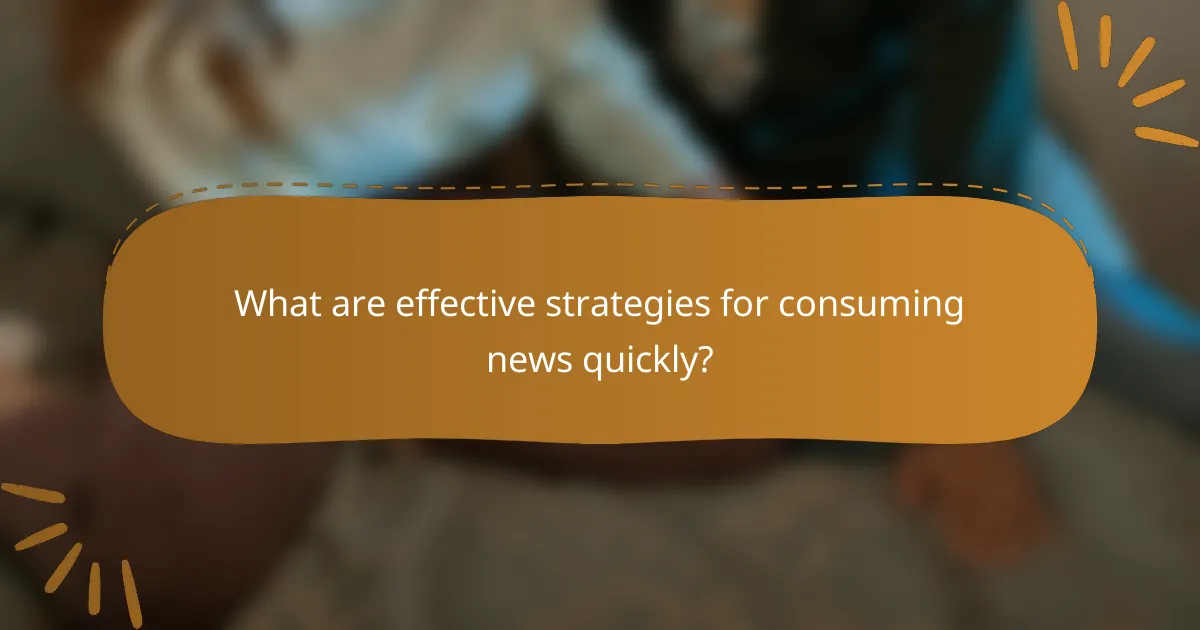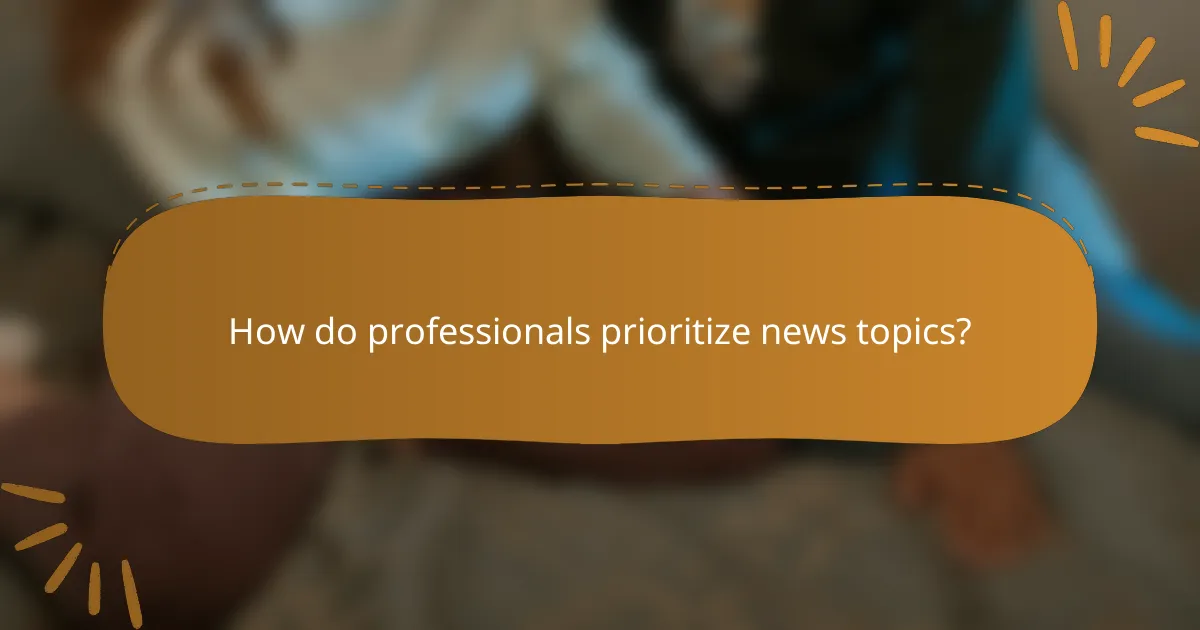Time constraints play a crucial role in shaping how professionals engage with news, often leading them to favor quicker, more digestible formats. As busy schedules demand efficiency, many individuals seek out sources that provide essential information in a rapid manner, allowing them to stay informed without compromising their time. Effective strategies, such as leveraging technology and customizing news sources, further enhance their ability to consume news efficiently.

How do time constraints affect news consumption for professionals?
Time constraints significantly influence how professionals consume news, leading to a preference for quicker, more digestible formats. With busy schedules, many individuals prioritize efficiency, opting for sources that deliver essential information rapidly.
Increased reliance on summaries
Professionals often turn to news summaries to stay informed without investing too much time. These concise overviews provide key points and essential context, allowing readers to grasp the main ideas quickly. Many platforms now offer daily or weekly summaries tailored for busy individuals, making it easier to keep up with important developments.
For instance, newsletters that compile top stories into brief bullet points can save time compared to reading full articles. This trend highlights the importance of clarity and brevity in news reporting.
Preference for audio and video formats
With limited time, many professionals prefer audio and video news formats that can be consumed on the go. Podcasts and video summaries allow individuals to engage with content while commuting or multitasking, making news consumption more flexible. This shift reflects a growing demand for formats that fit seamlessly into busy lifestyles.
For example, news apps that offer audio briefings or video highlights cater to those who want to stay updated without dedicating significant chunks of time to reading. This trend underscores the need for news outlets to adapt their content delivery methods.
Shift to mobile news apps
Mobile news apps have become essential tools for professionals managing time constraints. These applications provide instant access to news updates, allowing users to read or listen to stories whenever it suits them. The convenience of mobile access means that professionals can stay informed during short breaks or while on the move.
Many popular news apps feature customizable notifications, enabling users to receive alerts on topics of interest without sifting through irrelevant content. This personalization enhances the efficiency of news consumption, aligning with the fast-paced demands of professional life.

What are effective strategies for consuming news quickly?
Effective strategies for consuming news quickly include leveraging technology, setting strict reading times, and customizing news sources. These methods help professionals stay informed without overwhelming their schedules.
Utilizing news aggregation platforms
News aggregation platforms compile articles from various sources, allowing users to access multiple viewpoints in one place. Popular options include Feedly, Flipboard, and Google News, which can be tailored to specific interests.
When using these platforms, prioritize sources known for reliability and brevity. This ensures that the information consumed is both accurate and concise, saving valuable time.
Setting specific time limits for reading
Setting time limits for news consumption can enhance focus and efficiency. Aim for short sessions, such as 10-15 minutes, to quickly scan headlines and summaries rather than getting lost in lengthy articles.
Consider using timers or apps that promote focused reading. This approach helps prevent distractions and encourages a disciplined routine for staying updated.
Curating personalized news feeds
Curating personalized news feeds involves selecting specific topics, keywords, or sources that align with professional interests. This targeted approach reduces irrelevant information and streamlines the news consumption process.
Utilize features in news apps that allow you to follow certain topics or mute less relevant ones. Regularly review and adjust your selections to ensure the feed remains relevant and efficient.

Which news sources are preferred by busy professionals?
Busy professionals often prefer news sources that deliver concise, relevant information quickly. The Financial Times, The New York Times, and BBC News are among the top choices, each catering to specific needs and interests.
Financial Times for business news
The Financial Times is a leading source for business news, providing in-depth analysis and insights on global markets and economic trends. Professionals in finance and related fields often rely on its coverage to stay informed about market movements and corporate developments.
With a focus on financial reporting, the Financial Times offers features such as market data, expert opinions, and industry-specific articles. Subscribing to its daily newsletter can help busy professionals receive key updates directly to their inbox, saving time while keeping them informed.
The New York Times for diverse topics
The New York Times is recognized for its comprehensive coverage of various subjects, including politics, culture, technology, and health. This makes it a valuable resource for professionals seeking a well-rounded understanding of current events and societal trends.
Its digital platform allows users to customize their news feed based on interests, enabling busy professionals to quickly access relevant articles. The New York Times also offers podcasts and newsletters, which can be consumed during commutes or breaks, maximizing time efficiency.
BBC News for global updates
BBC News is a trusted source for global news, providing timely updates on international events, politics, and humanitarian issues. Professionals who operate in a global context often turn to BBC News for its reliable reporting and diverse perspectives.
The BBC’s mobile app and website offer real-time notifications and live updates, making it easy for busy professionals to stay informed about significant developments as they happen. Its emphasis on impartial reporting helps users gain a balanced view of global affairs, which is crucial for informed decision-making.

How do professionals prioritize news topics?
Professionals prioritize news topics based on their relevance to their industry, economic indicators, and regulatory changes. This focus helps them stay informed and make timely decisions that impact their work and organizations.
Focusing on industry-specific news
Professionals often concentrate on news that directly affects their sector, such as technological advancements, market trends, and competitor activities. By subscribing to industry newsletters, attending conferences, or following key influencers on social media, they can stay ahead of developments that may influence their business strategies.
For example, a finance professional might prioritize news about changes in interest rates or stock market fluctuations, while someone in healthcare may focus on new regulations or breakthroughs in medical technology. This targeted approach ensures that they allocate their limited time effectively.
Following major economic indicators
Monitoring major economic indicators is crucial for professionals as these metrics can signal shifts in market conditions. Key indicators include GDP growth rates, unemployment figures, and inflation rates, which can influence business decisions and investment strategies.
Professionals often use economic calendars to track the release of these indicators, allowing them to prepare for potential impacts on their industries. For instance, a rise in unemployment rates might prompt a retail manager to adjust inventory levels in anticipation of decreased consumer spending.
Staying updated on regulatory changes
Regulatory changes can significantly affect how businesses operate, making it essential for professionals to stay informed. This includes understanding new laws, compliance requirements, and industry standards that may impact their work.
To keep up with regulatory changes, professionals can subscribe to legal updates, join industry associations, or participate in webinars. For example, a financial advisor must be aware of changes in fiduciary standards to ensure compliance and protect their clients’ interests.

What role do social media platforms play in news consumption?
Social media platforms significantly influence news consumption by providing immediate access to breaking news and diverse perspectives. Professionals often rely on these platforms to stay informed quickly and efficiently, adapting their news intake to fit tight schedules.
Real-time updates on Twitter
Twitter serves as a primary source for real-time news updates, allowing users to follow live events and breaking stories as they unfold. With its character limit, tweets often provide concise summaries, making it easy for professionals to grasp key information quickly.
To maximize Twitter’s effectiveness, consider following reputable news organizations, journalists, and industry experts. Engaging with trending hashtags can also help you discover relevant news topics and discussions.
Visual storytelling on Instagram
Instagram leverages visual content to convey news stories, making complex topics more accessible through images and videos. This platform is particularly effective for storytelling, as visuals can evoke emotions and capture attention more than text alone.
For professionals, following news outlets and influencers on Instagram can provide quick insights into current events. Utilize Instagram Stories for timely updates, as they often feature breaking news and behind-the-scenes content that may not appear in traditional media.
Professional networking on LinkedIn
LinkedIn plays a unique role in news consumption by focusing on industry-specific news and professional insights. Users can share articles, comment on trends, and engage in discussions that are relevant to their fields, making it a valuable resource for staying informed.
To enhance your news consumption on LinkedIn, follow thought leaders and join industry groups. Regularly engaging with shared content can help you stay updated on developments that impact your profession while expanding your network.

How can professionals balance news consumption with work?
Professionals can balance news consumption with work by setting specific times for reading news and utilizing efficient sources. This approach allows them to stay informed without compromising productivity.
Integrating news into daily routines
To effectively integrate news into daily routines, professionals can allocate short, dedicated time slots throughout the day. For example, reading news during a morning coffee break or a brief session during lunch can help maintain awareness without overwhelming their schedule.
Using news aggregation apps can streamline the process by curating relevant articles based on interests and preferences. This can save time and ensure that only the most pertinent information is consumed.
Additionally, professionals should consider setting boundaries around news consumption to avoid distractions. Limiting news checks to specific times, such as once in the morning and once in the evening, can help maintain focus on work tasks while still staying updated.
